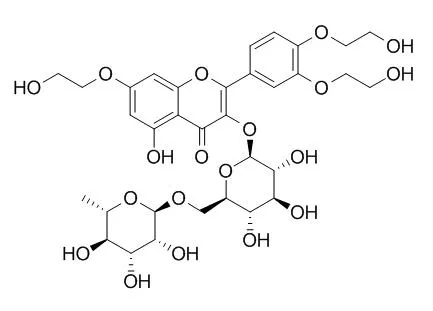| In vivo: |
| Arzneimittelforschung. 2005;55(10):573-80. | | Efficacy of troxerutin on streptozotocin-induced rat model in the early stage of diabetic retinopathy.[Pubmed: 16294503 ] | The vascular changes associated with early diabetic retinopathy, which include the formation of microaneurysms and acellular capillaries, vessel dilation, vascular endothelial growth factor expression, were investigated experimentally in streptozotocin-induced diabetic rats treated with antioxidants: Troxerutin (trihydroxy-ethylrutoside, CAS 7085-55-4), Vaccinium myrtillus, and calcium dobesilate (hydroquinone calcium sulfonate, CAS 20123-80-2).
METHODS AND RESULTS:
The development and progression of retinopathy was followed using fundus photography. After 3 months, the rats were sacrificed and half of the eyes were prepared for neovascularization analysis, and the other half were used for VEGF (vascular endothelial growth factor) analysis. However, there were no significant differences between the groups. The VEGF-mRNA density showed a increasing tendency by 20% in the diabetic rats compared with the non-diabetic rats (1.0 +/- 0.1 vs 1.2 +/- 0.1 VEGF/beta-actin), and this increase was corrected by 10 mg/kg Troxerutin (1.0 +/- 0.1 VEGF/beta-actin), 50 mg/kg Troxerutin (0.9 +/- 0.1 VEGF/beta-actin) and Vaccinium myrtillus (1.1 +/- 0.1 VEGF/beta-actin). Oxidative stress might be involved in the upregulation of retinal VEGF during early diabetes, and it is likely that Troxerutin has comparatively effective antioxidant properties.
CONCLUSIONS:
Therefore, Troxerutin might be a useful treatment for attenuating diabetic retinopathy. | | Brain. 2011 Mar;134(Pt 3):783-97. | | Troxerutin protects against high cholesterol-induced cognitive deficits in mice.[Pubmed: 21252113 ] | Recent findings suggest that neurotoxicity is the mechanism underlying the induction of neuronal insulin resistance by a high cholesterol diet. Troxerutin, a naturally occurring flavonoid, has been reported to possess biological activity beneficial to human health. Our recent studies have demonstrated that Troxerutin attenuates cognitive impairment and oxidative stress induced by D-galactose in mouse brain through decreasing advanced glycation end products, reactive oxygen species and protein carbonyl levels and enhancing phosphoinositide 3-kinase/Akt activation.
METHODS AND RESULTS:
In this study, we evaluated the effect of Troxerutin on cognitive impairment induced by brain insulin resistance in mice fed a high-cholesterol diet, and explored its potential mechanism. Our results showed that oral administration of Troxerutin to these mice significantly improved behavioural performance in a step-through passive avoidance task and a Morris water maze task, at least in part, by decreasing the levels of reactive oxygen species, protein carbonyl and advanced glycation end products and blocking endoplasmic reticulum stress via reduced phosphorylation of the pancreatic endoplasmic reticulum-resident kinase and eukaryotic translation initiation factor 2α. Furthermore, Troxerutin significantly inhibited the activation of c-jun N-terminal kinase 1 and IκB kinase β/nuclear factor-κB induced by endoplasmic reticulum stress and enhanced insulin signalling pathway, which prevented obesity, restored normal levels of blood glucose, fatty acids and cholesterol and increased the phosphorylation of cyclic adenosine monophosphate response element-binding protein and the expression levels of c-fos in the hippocampus. Moreover, Troxerutin significantly inhibited endoplasmic reticulum stress-induced apoptosis and decreased the activation of caspase-12 and caspase-3, and reduced the mean optical density of the terminal deoxyribonucleotidyl transferase-mediated dUTP-digoxigenin nick end label-positive cells in the hippocampus. However, intra-cerebroventricular infusion of PI-103, a specific phosphoinositide 3-kinase 110α inhibitor, significantly inhibited the expression levels of phosphoinositide 3-kinase 110α and phosphoinositide 3-kinase downstream signalling in the hippocampus of mice co-treated with high cholesterol and Troxerutin and vehicle control mice.
CONCLUSIONS:
These results suggest that Troxerutin could be recommended as a possible candidate for the prevention and therapy of cognitive deficits in type 2 diabetes mellitus and Alzheimer's disease. |
|






 Cell. 2018 Jan 11;172(1-2):249-261.e12. doi: 10.1016/j.cell.2017.12.019.IF=36.216(2019)
Cell. 2018 Jan 11;172(1-2):249-261.e12. doi: 10.1016/j.cell.2017.12.019.IF=36.216(2019) Cell Metab. 2020 Mar 3;31(3):534-548.e5. doi: 10.1016/j.cmet.2020.01.002.IF=22.415(2019)
Cell Metab. 2020 Mar 3;31(3):534-548.e5. doi: 10.1016/j.cmet.2020.01.002.IF=22.415(2019) Mol Cell. 2017 Nov 16;68(4):673-685.e6. doi: 10.1016/j.molcel.2017.10.022.IF=14.548(2019)
Mol Cell. 2017 Nov 16;68(4):673-685.e6. doi: 10.1016/j.molcel.2017.10.022.IF=14.548(2019)